Moses Jacob Ezekiel
| Moses Jacob Ezekiel | |
|---|---|
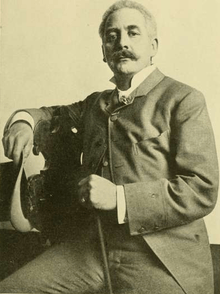 Moses Jacob Ezekiel in 1914 | |
| Born |
October 28, 1844 Richmond, Virginia, U.S. |
| Died |
March 27, 1917 (aged 72) Rome, Italy |
| Nationality | American |
| Education | Virginia Military Institute |
| Known for | Sculpture, Soldier |
Moses Jacob Ezekiel, also known as Moses "Ritter von" Ezekiel (October 28, 1844 – March 27, 1917) was a Jewish-American sculptor who lived and worked in Rome for the majority of his career. Among his numerous honors and prizes was the title of Cavaliere given by the Italian government. At the age of 29, Ezekiel was the first foreigner to win the Michel-Beer Prix de Rome.
He had been a cadet at the Virginia Military Institute and served in the American Civil War, including at the Battle of New Market. After the war, he completed his degree at VMI, and a few years later went to Berlin, where he studied at the Royal Academy of Art. He moved to Rome, where he lived and worked most of his life, selling his works internationally, including as commissions in the United States.
Life and career
Ezekiel was born in Richmond, Virginia, and attended the common schools. He was a graduate of the Virginia Military Institute; he was the first Jewish cadet to attend VMI.[1] He and other cadets from VMI marched 80 miles north from Lexington and fought at the 1864 Battle of New Market. He was wounded in a fight with Union army troops under Franz Sigel. After his recovery, he served with the cadets in Richmond to train new recruits for the army. Shortly before the end of the war, he served in the trenches defending the city.
Following the Civil War, Ezekiel returned to VMI to finish his education, graduating in 1866. He moved to Cincinnati in 1868, then to Berlin in 1869, where he studied at the Royal Academy of Art under Professor Albert Wolf. He moved to Rome, where he chiefly lived for the rest of his life. In Europe he completed the sculptures and paintings for which he is famous. He was admitted into the Society of Artists, Berlin, and at age 29 was the first foreigner to win the Michel-Beer Prix de Rome for a bas relief entitled Israel.
In the early 1880s, Ezekiel created eleven larger-than-life sized statues of famous artists. These were installed in niches on the facade of the Corcoran Gallery of Art's original building (now the Smithsonian's Renwick Gallery). In the early 1960s, they were removed to the Norfolk Botanical Garden in Norfolk, Virginia.
Although Ezekiel never married, he is known to have fathered a "natural" or illegitimate daughter, Alice Johnson (1879-1926). Her mixed-race mother was a maid in Washington, DC, where Johnson grew up. She was in contact with her father throughout his life. After graduating from Howard University, she became a school teacher. She married Daniel Hale Williams in 1898, who was also mixed race. He became a prominent, pioneering heart surgeon. They lived in Chicago for much of his career.[2][3]
Among his noted works was a memorial at VMI, Virginia Mourning Her Dead (1903). It was installed in the small cemetery where six of the 10 VMI cadets killed at the Battle of New Market are buried. He also created a Confederate Memorial (1914), which was installed at Arlington National Cemetery. Many of his works were of noted leaders.
Ezekiel died in his studio in Rome, Italy,[4] and was temporarily entombed there. In 1921, he was reinterred at the foot of his Confederate Memorial in Section 16 of Arlington National Cemetery. The inscription on his grave reads "Moses J. Ezekiel Sergeant of Company C Battalion of Cadets of the Virginia Military Institute."
Awards and honors
In his lifetime, Ezekiel received numerous honors: he was decorated by King Umberto I of Italy, the "Crosses for Merit and Art" from the German Emperor, another from Prince Frederick Johann of Saxe-Meiningen, and the awards of "Chevalier" (Cavaliere) and "Officer of the Crown of Italy" (1910) from King Victor Emmanuel III of Italy. Ezekiel received the Gold Medal of the Royal Society of Palermo, Italy; the Silver Medal at the 1904 Louisiana Purchase Exposition in St. Louis, Missouri; and the Raphael Medal from the Art Society of Urbino, Italy.
The honorific "Sir" by which Ezekiel is often referred is technically incorrect, as Ezekiel was never knighted by the monarch of the United Kingdom. More properly, his title was "Cavaliere" Moses Ezekiel, because of his Italian knighthood, or Moses "Ritter von" Ezekiel, because of his German honors. Ezekiel translated his Italian title into the English "Sir" on his visiting cards, resulting in the honorific by which he became known in English-speaking countries.[5]
In 1904, he was presented the New Market Cross of Honor at VMI by the Government of Virginia as one of the 294 cadets who fought at the Battle of New Market. As a veteran of the Civil War, Ezekiel was also entitled to wear the Civil War Campaign Medal.
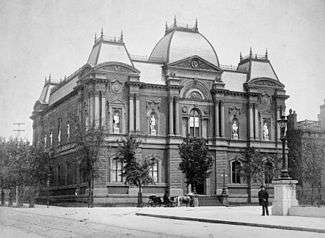
Works
- Bust of General Robert E. Lee
- Bust of Percy Bysshe Shelley in the Keats-Shelley Memorial House, Piazza di Spagna, Rome.
- Bust of Franz Liszt.
- Napoleon of St. Helena, statue in Rome, Italy.
- Religious Liberty (1876). Originally installed in Fairmount Park, Philadelphia, now installed at the National Museum of American Jewish History in the same city.
- Eve Hearing the Voice (1876), Cincinnati Art Museum, Cincinnati, Ohio.[6]
- Faith (1877), Peabody Institute, Baltimore, Maryland.[7]
- 11 Statues of Artists: Phidias, Raphael, Durer, Michelangelo, Titian, Murillo, Da Vinci, Correggio, Van Dyke, Canova, Thomas Crawford (1879–84). Originally installed in niches on the facade of the Corcoran Gallery of Art, Washington, DC. Now installed at "Statuary Vista", Norfolk Botanical Garden, Norfolk, Virginia.[8]
- Bust of Jessica (1880), Smithsonian American Art Museum, Washington, DC.[9]
- Bust of Judith (c. 1880), Cincinnati Art Museum, Cincinnati, Ohio.[10]
- Ecce Homo (1884), Cincinnati Art Museum, Cincinnati, Ohio.[11]
- Bust of Thomas Jefferson (1888), United States Capitol, Washington, DC.[12]
- Statue of Christopher Columbus (1892), Arrigo Park, Chicago, Illinois.[13] Commissioned for the 1893 Worlds Columbian Exposition.
- Jefferson Monument (1901), Louisville Metro Hall, Louisville, Kentucky.
- A 1910 replica of this is at the University of Virginia, Charlottesville, Virginia.
- Virginia Mourning Her Dead (1903), Virginia Military Institute, Lexington, Virginia.
- A replica of this is at the Museum of the Confederacy, Richmond, Virginia.
- Statue of Anthony J. Drexel (1904), Drexel University, Philadelphia, Pennsylvania.
- Bust of Anthony J. Drexel (1905), Drexel University, Philadelphia, Pennsylvania.
- Statue of Homer (1907), University of Virginia, Charlottesville, Virginia.
- Statue of Stonewall Jackson (1910), West Virginia State Capitol, Charleston, West Virginia.[14]
- A replica of this is at the Virginia Military Institute.
- The Lookout (1910), Confederate Cemetery, Johnson's Island, Ohio.
- Bust of Governor Andrew Gregg Curtin (1912), Smith Memorial Arch, West Fairmount Park, Philadelphia, Pennsylvania.[15]
- Confederate Memorial (1914), Arlington National Cemetery, Arlington, Virginia.[16]
- Statue of Edgar Allan Poe (1917), University of Baltimore, Baltimore, Maryland.[17]
Gallery
 Bas relief of Sarah Workum, private collection.
Bas relief of Sarah Workum, private collection.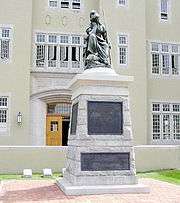 Virginia Mourning Her Dead (1903), Virginia Military Institute, Lexington, VA.
Virginia Mourning Her Dead (1903), Virginia Military Institute, Lexington, VA.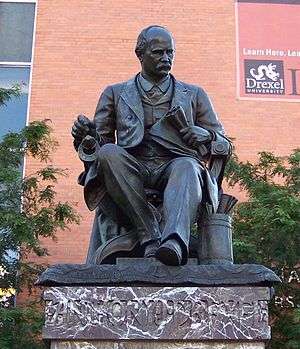 Anthony J. Drexel (1904), Drexel University, Philadelphia, PA.
Anthony J. Drexel (1904), Drexel University, Philadelphia, PA.- Bust of Anthony J. Drexel (1905), Drexel University, Philadelphia, PA.
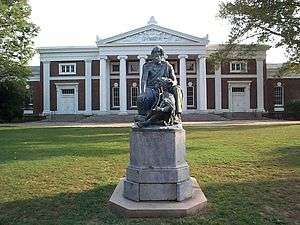 Homer (1907), University of Virginia, Charlottesville, VA.
Homer (1907), University of Virginia, Charlottesville, VA. The Lookout (1910), Confederate Cemetery, Johnson's Island, OH.
The Lookout (1910), Confederate Cemetery, Johnson's Island, OH.- Jefferson Monument (1910), University of Virginia, Charlottesville, VA.
- Bust of Andrew Gregg Curtin (1912), Smith Memorial Arch, Philadelphia, Pennsylvania.
 Confederate Soldiers Memorial (1914), Arlington National Cemetery, Arlington, VA.
Confederate Soldiers Memorial (1914), Arlington National Cemetery, Arlington, VA.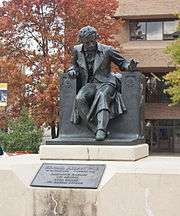 Statue of Edgar Allan Poe (1917), University of Baltimore, Baltimore, Maryland.
Statue of Edgar Allan Poe (1917), University of Baltimore, Baltimore, Maryland.
In popular culture
Ezekiel was portrayed by Josh Zuckerman in the 2014 film Field of Lost Shoes, which depicted the Battle of New Market.
References
Notes
- ↑ Civil War Trust biography of Moses Ezekiel
- ↑ The Booker T. Washington Papers, Vol.9, footnote, p. 396, November 1907, U. of Illinois Press Archived 2007-10-20 at the Wayback Machine.
- ↑ Helen Buckler, Doctor Dan: Pioneer in American Surgery, (originally published before 1923; reprinted by Nabu Press, 2011), pp. 147-58, 226-27. Another edition, published in 1968, is Buckler's Daniel Hale Williams, Negro Surgeon.
- ↑ Levy, Florence Nightingale (1917). American Art Directory, Volume 14. The American Federation of the Arts. p. 322.
- ↑ Making of America Project (1939). The North American Review. University of Northern Iowa.
- ↑ Eve Hearing the Voice from Cincinnati Art Museum.
- ↑ Faith from Peabody Art Collection.
- ↑ Statuary Vista Archived 2011-07-18 at the Wayback Machine. from Norfolk Botanical Garden.
- ↑ Jessica from Flickr.
- ↑ Judith from Cincinnati Art Museum.
- ↑ Ecce Homo, (sculpture) from Smithsonian Institution CollectionsSearchCenter.
- ↑ Jefferson from U.S. Senate.
- ↑ Columbus Statue from Waymarking.com.
- ↑ Stonewall Jackson
- ↑ Governor Curtin bust from Philadelphia Public Art.
- ↑ Confederate Soldiers Memorial from Arlington National Cemetery.
- ↑ Poe Statue Archived 2010-12-25 at the Wayback Machine. from University of Baltimore Law School.
Bibliography
- Cohen, Stan and Keith Gibson. Moses Ezekiel: Civil War Soldier, Renowned Sculptor, Pictorial Histories Publishing Company, Inc., 2007. ISBN 1-57510-131-9
- Gutmann, Joseph and Stanley F. Chyet (ed.) Moses Jacob Ezekiel: Memoirs from the Baths of Diocletian, Detroit : Wayne State University Press, 1975. ISBN 0-8143-1525-9
- Harlan, et al. (eds.). Booker T. Washington Papers, Vol. 9, p. 396
- Leepson, Marc. "Sculpting the Cause", Civil War Times Illustrated, Vol. 46, Issue 9, November–December 2007.
- Nash, Peter Adam. The Life and Times of Moses Jacob Ezekiel: American Sculptor, Arcadian Knight. Madison-Teaneck:Fairleigh Dickinson University Press, 2014.
- New York Times, "Ezekiel, Sculptor, Arrives: Here to Attend Unveiling of His Statue of Jefferson in Charlottesville", May 25, 1910.
- New York Times obituary
- Wrenshall, Katharine H. (November 1909). "An American Sculptor In Rome: The Work of Sir Moses Ezekiel". The World's Work: A History of Our Time. XIX: 12255–12263. Retrieved 2009-07-10.
External links
| Wikimedia Commons has media related to Moses Jacob Ezekiel. |